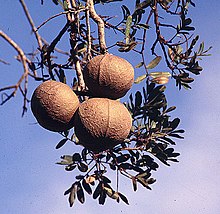Magonia pubescens
| Magonia pubescens | ||||||||||||
|---|---|---|---|---|---|---|---|---|---|---|---|---|
| Systematics | ||||||||||||
|
||||||||||||
| Scientific name of the genus | ||||||||||||
| Magonia | ||||||||||||
| A.St.-Hil. | ||||||||||||
| Scientific name of the species | ||||||||||||
| Magonia pubescens | ||||||||||||
| A.St.-Hil. |
Magonia pubescens is a tree in the soap tree family from northeast Argentina , Paraguay , Bolivia to central, southeastern, and northern Brazil . It is the only species in the genus Magonia . In Brazil he is known as Tingui and in Bolivia as Barbasco .
description
Magonia pubescens grows as a deciduous, quite fast-growing tree, with a dense crown to about 9-10 meters high. The trunk diameter reaches about 30 centimeters. The grayish to brownish bark has small scales.
The alternate and stalked leaves are pinnate in pairs with about 6–12 leaflets . The entire, ovate to obovate, oblong or ovate to ovate to ovate and rounded or rounded to indented, edged leaflets are (almost) sessile. They are up to 11.5 inches long and up to 6 inches wide, they are lighter underneath and slightly hairy. The stipules are missing.
Magonia pubescens is monoecious . Fine-haired and loose, paniculate , terminal or axillary inflorescences are formed. The stalked and five-fold, functionally unisexual, slightly fragrant flowers have a double flower envelope . The fine-haired, five-part and small calyx is yellow-greenish. The elongated, narrow, about 1–1.3 centimeters long and spreading petals are fine-haired and yellow-green on the outside and purple-red on the inside. There are about 8 stamens . The three-chambered, short hairy ovary is on top. The male flowers have a pistillode and the female staminodes. There is a cup-shaped, double-layered disc on one side and here elongated concave upwards .
Spherical, about 7.5–11.5 centimeters in size, brownish and slightly scabbed, somewhat rough, glabrous, woody, loculicidal, three-part, multi-seeded capsule fruits are formed. The flat, orange-brown, elliptical to kidney-shaped, myxosperm seeds, with a soft, papery seed coat are winged all around and with wings about 5.5–8.5 centimeters long.
use
The leaves can be used as fish poison . The bark is used medicinally. Soap can be made from the seed oil.
The fairly durable, moderately hard and heavy wood can be used for various applications.
literature
- John Lindley : Flora medica. 1838, p. 122, online at biodiversitylibrary.org.
- Daiane Maia de Oliveira, Maria Olvia Mercadante-Simões, Leonardo Monteiro Ribeiro, Ariadna Conceição dos Santos: Ontogenesis of the winged oleaginous seeds of Magonia pubescens (Sapindaceae). In: Flora. 229, 2017, pp. 159–170, doi: 10.1016 / j.flora.2017.02.027 , online at kundoc.com.
- Milton Groppo, María Silvia Ferrucci, Katia Freira da Silva: Flora da Serra do Cipó, Minas Gerais: Sapindaceae. In: Bol. Bot. Univ. São Paulo. Vol. 31, No. 1, 2013, pp. 99-130, doi: 10.11606 / issn.2316-9052.v31i1p99-130 , online at researchgate.net.
- A. Engler : The plant kingdom. IV. 165, Engelmann, 1934, pp. 1469-1474, online at biodiversitylibrary.org.
- A. Engler: The natural plant families. III. Part, 5th section, Engelmann, 1896, p. 363 f, online at biodiversitylibrary.org.
- Mémoires du Muséum d'histoire naturelle. 12, 1825, pp. 336-340, 348, Pl. XII, XIII, online at biodiversitylibrary.org.
Web links
- Magonia pubescens at Useful Tropical Plants.
- Magonia pubescens near Árvores do Bioma Cerrado.

